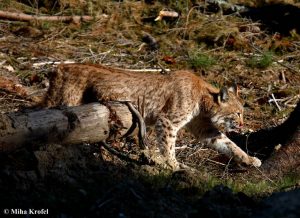Project Title
Preventing the Extinction of the Dinaric-SE Alpine Lynx Population Through Reinforcement and Long-term Conservation
Acronym
LIFE Lynx
Reference
LIFE16 NAT/SI/000634
Project Time Frame
01/07/2017 – 31/03/2024
Total Project Budget
6,829,377.00 €
EU Financial Contribution
4,081,404.00 €
Project partners
Abstract

Foto: Miha Krofel
LIFE Lynx project’s primary objective is rescuing the Dinaric-SE Alpine lynx population from extinction and to preserve it in the long term. Before the start of the project, the population was small, isolated, and extremely inbred. It urgently needed reinforcement by introducing additional, healthy animals from another population. We are reinforcing the Dinaric-SE Alpine population with lynx from the viable source population in the Carpathians, while maintaining high public support. We are collaborating across all EU countries sharing this population to develop and implement a systematic approach to ensure long-term viability of the reinforced population. We work closely with core stakeholders to further develop partnerships and to ensure broad public acceptance of lynx conservation. We aim to develop science-based management tools for strategic planning to ensure long-term viability of lynx. These include using computer modelling based on data from the project to understand how to genetically and demographically manage the population for the long term. This scientific information will be incorporated into management plans and other strategic documents. Another objective is to improve population connectivity for lynx. Natural gene flow of lynx within this population will be increased, in order to avoid additional reintroductions in the future. Such a metapopulation will help reduce negative impacts of habitat fragmentation and will reverse genetic deterioration across entire Dinaric-SE Alpine population.

Foto: Miha Krofel
Background
The Dinaric-SE Alpine lynx population went extinct at the beginning of 20th century due to hunting and persecution, habitat loss and lack of prey species. It was successfully reintroduced in the 1973 by translocating animals from a Carpathian source to Slovenia. The animals then spread towards the south-east to Croatia and Bosnia and Herzegovina, as well as to Italy in the west and Austria in the north. Unfortunately, after a few decades, the population started declining, mainly due to genetic deterioration (inbreeding and genetic drift). Today, to save the population, urgent measures are needed to refresh and enrich the existing population and to improve its connectivity with other populations, especially the Alpine one.

Foto: Miha Krofel
Objectives
- The project aims to save the Dinaric-SE Alpine lynx population from extinction by improving the genetic and demographic outlook of this population by directly increasing population viability through reinforcement, and to safeguard the population well into the 21st century.
The project expects to reverse the decline of the Dinaric-SE Alpine lynx population that will be reinforced with the release of animals from a viable source population from the Carpathians, so that level of inbreeding will be reduced. - Conservation management will be developed at the transboundary level. We will collaborate across all EU countries sharing this population to develop and implement a standardized and systematic approach to ensure long-term viability of the reinforced population.
- The reinforcement will be a stakeholder-supported process to foster broad public acceptance. We will work closely with core stakeholders to establish and further develop partnerships to ensure broad public acceptance of lynx conservation. We will safeguard core stakeholder support of lynx reinforcement in targeted areas at local, regional, and national levels, while regularly informing and maintaining support among the broader public.
- We will develop science-based management tools for strategic planning and decision-support tools. To ensure the long-term viability of lynx, we will use computer modelling based on data from the project to understand how to genetically and demographically manage the population in the long term. This scientific information will be incorporated into management plans. These objectives are strongly linked to the Bern Convention, Annex II of the Habitats Directive and the Biodiversity Strategy 2020.
- We wish to improve population connectivity for lynx through increasing the chances of natural gene flow by creating a population “stepping stone” to generate a new population nucleus further west of the current Dinaric population, thus bringing the SE-Alpine nucleus closer. Such a metapopulation of lynx will help reduce negative impacts of habitat fragmentation.
